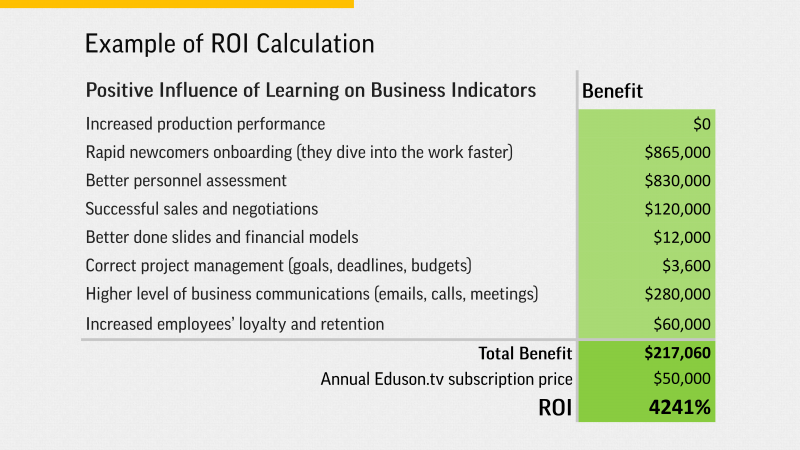Calculating eLearning ROI
Studies show that companies are still skeptical about the value of free online courses. Today 70% of employers do not trust the credibility of their completion. Is your CEO among them?
As executives watch eLearning budgets grow, they need clear evidence showing that eLearning programs can really help performance. Learning and Development managers try to find killer arguments in defense of eLearning. What do they do and why do they fail to convince the executives?
How Do We Measure eLearning Effectiveness?
- Employees’ feedback.
Often Learning and Development departments collect feedback from the employees to understand how well the training was perceived. Did they feel that the course was a valuable experience? Did they like the topic, the material, the way it was presented? The employees’ opinion is definitely valuable but it has nothing to do with the real and tangible impact of eLearning on business goals evaluation. - Control questionnaires and tests.
How much has the trainees’ knowledge increased as a result of the training? It’s important to measure this, but again, the fact that the employees know what to do does not guarantee that they will apply this knowledge. - Control groups.
After the online course completion the staff who did not take the course is used as a control group. The production results of the two groups are compared in order to find any correlations. The use of this approach appears to be reasonable only for the simple and short-termed processes (e.g. lead response time, number of solved tickets, etc.). While most of business processes are much more complex, the control group method proves to be insufficient. - HR metrics.
Sometimes the level of employee retention, satisfaction and loyalty may be considered as a result of successful eLearning. But the other factors such as salary, career opportunities, corporate culture, etc. can turn out to be much more important for the people.
Why Calculate eLearning ROI?
The truth is that at the C-level, it’s all about quarterly and annual revenue and earnings. Most importantly, managers at this level are first and foremost focused on a “hard dollar” measurement. In other words, they need to know the return-on-investment rate which will provide them with quantitative results and enable decision making.
Like any other cost center in the company, Learning and Development department has to show that it delivers real tangible benefit to the organization. If it can't demonstrate such value, then it is likely to not get support within the company. 
Know The Costs
- Personnel.
Includes cost of people (both internal and external consultants) that will be needed to build the program. Don’t forget to value the time of staff who is involved in the process while also playing other (non-eLearning) roles. - eLearning Technology.
eLearning is largely a technology driven process. Often, organizations need to tailor a newly acquired technology to assimilate it into the company's existing IT infrastructure. According to Bersin by Deloitte, there are over 500 Learning Management System vendors on the market. Their price may vary greatly so each company can find a solution at a reasonable price starting at $5 per employee per month. - eLearning Content.
The costs should also include content development (in case when some unique content needs to be created), or ready-made content acquisition costs.
Measure The Value
- Eliminated travel and lodging costs.
These costs are the biggest reason why the large corporations implement eLearning. Also, they are a major component of any ROI calculation, and eLearning can dramatically reduce such costs. - Decreased instructor costs.
No matter whether the training is led by a famous coach or a company staff member, it is always much cheaper to have the trainer record the lecture once than speak in person at each location for many times. - Decreased employees’ work time spending.
eLearning offers employees the flexibility to learn anywhere and anytime: on their way from home to work, as well as on weekends and vacations. Typically, the time a person must spend being trained is reduced by about 40% using eLearning. - Flexibility.
Just answer the question: How many employees don't learn (how to follow a new process or how to operate a new tool) because of a rigid learning schedule, and what does it cost the company as a result? - Personalized learning.
Individuals can learn at their own speed, due to personalized learning, which is more efficient in delivering content. For instance, the IBM eLearning program for managers enabled the participants to learn 5 times more material through eLearning – without increasing the time spent on training.
These are the common eLearning costs and benefits. Still, you can find a lot of company-specific metrics: Manufacturing performance, software proficiency, personnel assessment, etc.
In Any Unclear Situation Go Calculate ROI
This is the example of eLearning project ROI calculation for one of the Eduson.tv clients (a financial organization). You can use this template or create a new one for your company.
Download here an excel model to calculate ROI for your company.

There are also some free eLearning ROI calculators which can be useful for evaluating online training performance:
- www.caelearning.com
- www.bridgefront.com
- www.aadm.com
Complete the fields in order to calculate and compare the costs of online and instructor-led training.
So, What Should Learning And Development Managers Do?
For each dollar budgeted for corporate training, 80% goes to administrative overhead, and just 20% goes to the core instructional design process.
You need to identify the “black holes” that consume your training budget and get rid of them.
In conclusion, it is important to understand that eLearning is not only an attractive solution in terms of economic downturn, but it is also an efficient and cost-effective solution when employees need to be quickly educated on relevant knowledge and skills, in spite of their location and time zone. By accurately calculating the cost of a training program, eLearning professionals will be able to easily justify the investment in the program and decide if eLearning is ultimately a viable solution.









